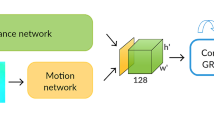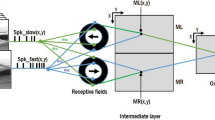Abstract
This paper proposes a new neural algorithm to perform the segmentation of an observed scene, into regions corresponding to different moving objects by analyzing a time-varying images sequence. The method consists of a classification step, where the motion of small patches, is characterized through an optimization approach, and a segmentation step merging neighboring patches characterized by the same motion. Classification of motion is performed without optical flow computation, but considering only the spatial and temporal image gradients into an appropriate energy function minimized with a Hopfield-like neural network giving as output directly the 3D motion parameter estimates. Network convergence is accelerated by integrating the quantitative estimation of motion parameters with a qualitative estimate of dominant motion using the geometric theory of differential equations.
Similar content being viewed by others
Explore related subjects
Discover the latest articles, news and stories from top researchers in related subjects.References
Bajcsy R, Campos M. Active and exploratory perception.International Journal of Computer Vision, 1992, 56(1): 31–40.
Shu C F, Jain R. Vector field analysis for oriented pattern.IEEE Trans. PAMI, 1994, 16(9): 946–950.
Campani M, Verri A. Motion analysis from first-order properties of optical flow.CVGIP: Image Understanding, 1992, 56(1): 90–107.
Black M J, Anandan P. The robust estimation of multiple motions: Parametric and plecewise-smooth flow fields.Computer Vision and Image Understanding 1996, 63(1): 75–104.
Rao A R, Jain R C. Computerized flow field analysis: Oriented texture fields.IEEE Trans. PRMI, 1992, 14(7): 693–709.
Verri A, Girosi F, Torre V. Mathematical properties of the two-dimensional motion field, from singular points to motion parameters.J. Opt. Soc. Am, 1989 6(5): 912–921.
Verri A, Poggio T Motion field and optical flow: Qualitative properties.IEEE Trans. PRMI, 1990, 11(5): 490–498.
Chellappa W R, Zheng Q. Experiments on estimating egomotion and structure parameters using long monocular image sequence.International Journal of Computer Vision 1995, 15: 492–515.
Zhou Y T, Chellappa R. A heural network for motion processing. InNeural Network for Perception, 1993, Vol. 1 (Academic Press-ISBN0-12-741251-4), pp.492–515.
Author information
Authors and Affiliations
Additional information
This paper was supported by the National Natural Science Foundation of China under Nos.69585002 and 69785003.
YANG Jingan is presently a Professor in computer sciences, supervisor of Ph.D. candidates, Deputy Director, School of Computer & Information Sciences, Fellow Academy Member, New York Academy of Sciences, Senior Member of the IEEE Senior Member of the IEEE Computer Society, Vice-Director of Anhui Province Computer Federation, National Distinguished Expert of China. He studied at University of Science & Technology of China for two years after he graduated from Hefei University of Technology in 1969. He was awarded the title of 1998 Anhui provinc distinguished teacher. He is currently engaged in teaching and scientific research on computer vision, artificial intelligence and robotics, knowledge engineering, and multimedia computer technique and visual reality. He has authored more than 140 papers and published 2 books.
Rights and permissions
About this article
Cite this article
Yang, J. A neural paradigm for time-varying motion segmentation. J. Comput. Sci. & Technol. 14, 539–550 (1999). https://doi.org/10.1007/BF02951873
Received:
Revised:
Issue Date:
DOI: https://doi.org/10.1007/BF02951873




